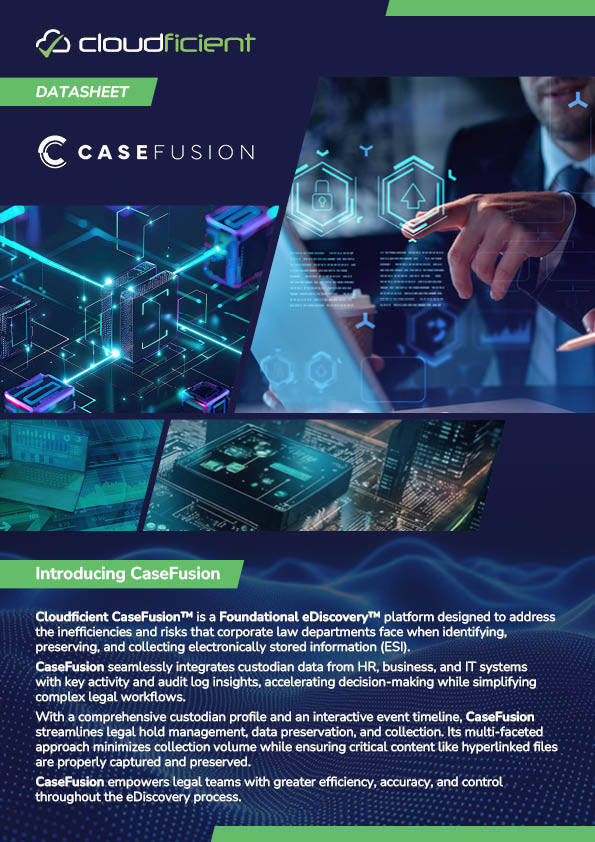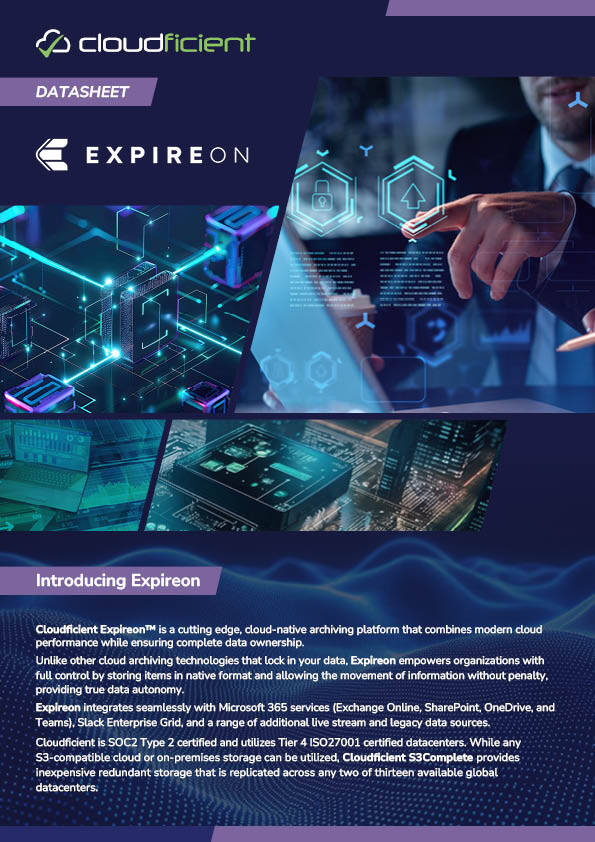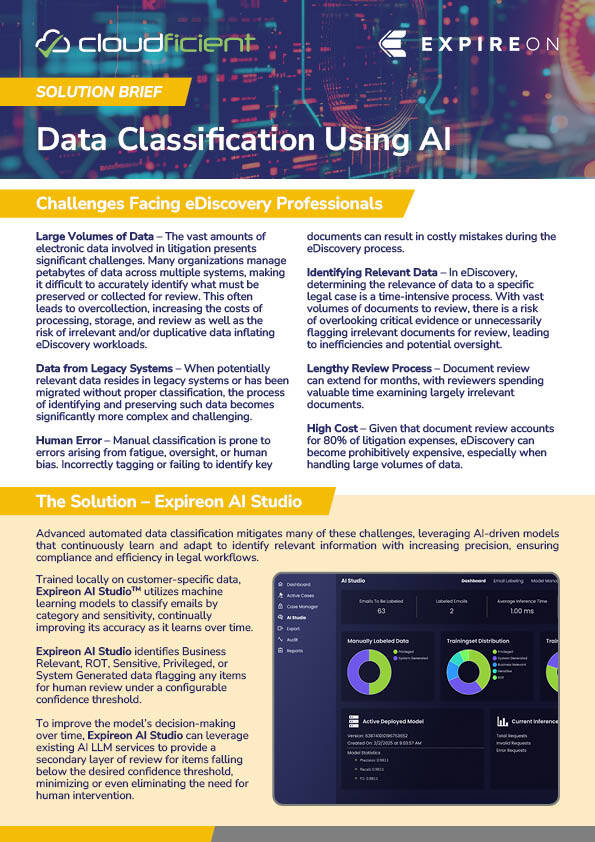- Solutions
- Information Governance
- Employee Offboarding
Modern Offboarding Strategies to Eliminate Data Risks and Reduce Licensing Costs
Employees leaving an organization has become a complex information governance challenge that creates significant spoliation risks and leads to escalating costs. Without a reliable employee offboarding process, legal and IT teams struggle with data discovery, inconsistent retention policies, and per-user licensing models that compound expenses as data from departed employees accumulates.
Incomplete Data Identification and Preservation
Without a comprehensive overview of the employee's "data map", organizations struggle to identify and preserve all relevant data before account deactivation. This incomplete approach to offboarding leaves organizations vulnerable to missing critical evidence across multiple data sources, generating problems such as:
-
-
Fragmented data discovery: Traditional offboarding processes often fail to capture data scattered across Microsoft 365, Slack, SharePoint, and legacy systems, resulting in gaps in preservation that expose organizations to spoliation claims.
-
Incomplete custodian data mapping: Without understanding employees’ footprint across systems and platforms, IT teams cannot effectively identify all data sources associated with departing employees, leaving potential evidence unpreserved.
-
Cross-platform preservation failures: Manual employee offboarding approaches struggle to coordinate data preservation across the IT environment, especially for unstructured data like email, chat, file shares, and other less prominent cloud applications in particular.
-
Time-sensitive preservation gaps: Standard offboarding processes often prioritize system access removal over comprehensive data identification, creating windows where critical information can be lost or altered by co-workers or alternative logins, such as guest or temporary accounts.
-


Legal Hold Complications and Spoliation Risks During Transitions
Employee departures create complex legal hold scenarios where organizations must balance security concerns with litigation preservation requirements. Without offboarding processes that honor legal hold requirements, companies face significant spoliation exposure, particularly when retention policies conflict with preservation obligations, creating challenges like:
-
Premature data deletion during account deactivation: Automated retention policies may trigger data destruction before legal teams can implement proper holds, or when licenses are removed creating spoliation liability during employee transitions.
-
Legal hold notification failures: Traditional offboarding processes lack workflows to notify legal teams of departing employees who may be subject to existing or potential litigation holds.
-
Insufficient preservation scope: Manual approaches to employee offboarding often miss hyperlinked documents, shared files, and collaborative content that departing employees accessed or modified, often in co-workers repositories such as a shared OneDrive.
-
Documentation gaps: Without systematic audits and reports organizations struggle to maintain defensible records of what data was preserved and why, creating audit trail vulnerabilities.
Missing Evidence from Hyperlinked Documents and Referenced Files
During employee offboarding, organizations frequently overlook the complex web of hyperlinked documents and referenced files that departing employees created, accessed, or modified. This creates significant evidence gaps that surface during eDiscovery, particularly when hyperlinked content changes after employee departure, resulting in problems including:
-
Lost version control: Without offboarding processes that take hyperlinked resources into account, organizations fail to preserve specific versions of hyperlinked files. Only storing the current version, not those that existed when departing employees accessed them, creates evidence authenticity issues.
-
Incomplete content preservation: Standard tools often fail to capture shared documents, team files, and collaborative content that departing employees contributed to or referenced in email and chat communications. The message has been captured, but not the hyperlinked file.
-
Broken reference chains: Even if the preserved emails and chats are captured, but the hyperlinked documents referenced within are not, it should be considered an incomplete evidence package.
-
File access gaps: Manual offboarding procedures cannot track which shared files were accessed by departing employees, leaving organizations unable to identify all potentially relevant evidence sources like Groupshares or Teamsites in Sharepoint.


Inconsistent Data Classification and Retention
Without automated classification systems, organizations struggle to apply consistent retention policies to departing employee data. This creates compliance risks and makes it difficult to establish defensible information governance strategies during personnel transitions, generating problems including:
-
Variable classification decisions: Different team members apply inconstant standards when categorizing business-relevant, sensitive, and privileged content during offboarding processes.
-
Conflicting retention policy application: Regulatory requirements and organizational policies often prohibit sending privileged communications to external AI classification services.
-
Cross-department coordination: Without standardized offboarding processes, legal, IT, and HR teams apply different data classification standards during employee transitions.
-
Audit trail inconsistencies: Missing data classification makes it difficult to defend retention decisions for departing employee information.
Integration Gaps and Data Silos
Many organizations maintain legacy archives and Information Governance systems that tend to complicate employee offboarding processes. Without unified data management platforms, IT teams struggle to coordinate preservation across old archives, acquired company systems, and modern cloud applications, creating significant blind spots during employee transitions, generating challenges like:
-
Legacy data identification: Traditional offboarding processes cannot effectively identify departing employee data stored in legacy archives or acquired company systems, creating preservation gaps. Example: The OneDrive of an assistant is not retained, therefore the documents residing there that were shared with a senior manager are lost.
-
Cross-system preservation failures: Manual approaches struggle to implement consistent retention policies across legacy systems, modern cloud platforms, and hybrid environments during offboarding so that policy changes are consistently reflected across all repositories.
-
Data migration complications: In many cases, employee offboarding reveals integration challenges for leaver data. When trying to consolidate or migrate departing employee data from legacy systems to modern archives, it is important to have a strategy for former employees without Active Directory accounts or licenses.
-
Audit trail fragmentation: Many organizations forget to create and maintain comprehensive records when making offboarding decisions across multiple systems and data repositories, causing them to lose metadata like log-files and audit records from those systems. This data can be important later to help you understand who accessed what data, and when.


High Cost of Over-Preservation
Many organizations choose to over-preserve departing employee data rather than risk missing important information. This approach dramatically increases storage costs and licensing expenses, particularly when ROT (Redundant, Obsolete, Trivial) and system-generated content represent significant portions of the preserved data, creating challenges including:
-
Expensive long-term storage of irrelevant content: Without effective data classification, organizations preserve massive volumes of non-business-relevant data that inflate ongoing storage costs.
-
Inflated licensing costs: Traditional approaches to employee offboarding require preserving all departing employee data without separating business-relevant content from system-generated and redundant files.
-
Extended preservation timelines: Over-inclusive offboarding strategies create storage burdens that persist long after an employee's departure, increasing storage costs.
-
Resource allocation: Manual preservation of irrelevant content during offboarding diverts IT resources from strategic initiatives.
Licensing Costs for Inactive Users
Many archive and eDiscovery platforms now require licenses for every user whose data can be searched or accessed, forcing organizations to pay ongoing fees for all former employees’ archived information. This licensing model dramatically increases license expenditures as companies accumulate years of departed employee data. Keeping all data searchable for litigation and compliance purposes, generates budget challenges such as:
-
Per-user licensing for all historical employees: Archive platforms charging monthly or annual licenses for every former employee whose data remains searchable, leading to costs compounding over time as workforce turnover increases.
-
Mandatory license retention for searchable archives: Several cloud-based data management solutions require active user licenses to maintain search capabilities against departed employee data, preventing organizations from reducing licensing costs after offboarding.
-
Exponential cost growth with employee turnover: Per-user licensing models create budget pressures that increase geometrically as organizations must maintain licenses for current employees plus all former employees whose data remains archived and searchable.
-
Unpredictable long-term financial commitments: User-based licensing for archived data makes forecasting archiving costs virtually impossible, because it is impossible to predict future workforce changes or litigation hold requirements for departed employees.


Time-Sensitive Account Deactivation vs Data Preservation Balance
Employee offboarding creates tension between immediate security requirements for account deactivation and comprehensive data preservation needs. Without sophisticated workflows that can coordinate these competing priorities, organizations face either security vulnerabilities or data preservation gaps, generating challenges like:
-
Security vs. preservation timing conflicts: Immediate account deactivation requirements often conflict with data identification needs, forcing organizations to choose between security and preservation.
-
Insufficient preservation windows: Rushed processes provide inadequate time for thorough data identification and preservation before system access removal, putting stress on IT teams and potentially leading to errors and mistakes.
-
Coordination failures between IT and legal teams: Traditional offboarding workflows are run by IT, with generic input from Legal and Records Management. To balance security requirements with legal preservation obligations during employee transitions a much closer communication is required.
-
Documentation gaps: Many organizations struggle to maintain defensible records of why specific retention & timing decisions were made during employee offboarding procedures.
Implement Locally Trained Models with Continuous Learning Capabilities
Deploy modern, AI-based data discovery systems that automatically identify and map departing employee information across Microsoft 365, Slack, SharePoint, OneDrive, Teams, and legacy archives as an integral part of your offboarding process. Deep cross-platform integration between the AI-engine and your data sources ensures complete data identification without manual coordination, reducing spoliation risks and critical evidence gaps. Organizations implementing automated employee data discovery achieve consistent data preservation results, eliminating the blind spots that create spoliation exposure.
Establish AI-Powered Classification to Prevent Spoliation and Reduce Costs
Intelligent classification systems automatically categorize departing employee data by relevance, sensitivity, and business value, preventing over-preservation while ensuring critical information remains protected. AI-powered classification reduces storage costs by identifying ROT content and system-generated data that can be safely excluded from long-term preservation. Organizations using automated classification achieve significant cost savings while maintaining defensible spoliation protection.
Design Integrated Legal Hold Workflows for Employee Offboarding Processes
Create workflows that coordinate legal hold requirements with IT offboarding procedures, ensuring departing personnel subject to litigation holds receive appropriate data preservation. Integrating offboarding mechanisms with legal hold workflows prevents premature data deletion. Enabling account deactivation and access removal while protecting the data on hold, reduces spoliation risks from timing conflicts. Organizations with coordinated hold processes eliminate the conflicts between security requirements and preservation obligations during offboarding.
Maintain Complete Data Sovereignty with Modern Cloud- Native Architecture
Modern cloud-native archiving solutions provide complete data ownership and control without vendor lock-in or export fees during employee offboarding.Maintaining data sovereignty ensures organizations keep full control over departing employee information while benefiting from modern cloud performance and scalability. Those platforms eliminate the integration challenges and data silos that complicate traditional offboarding processes.
Create Intelligent Retention Policies
Establish consistent, defensible retention policies based on AI classification results and regulatory requirements. Intelligent retention policies eliminate the inconsistencies of manual decision-making, preventing spoliation claims from inconsistent data handling. Organizations implementing automated retention policies consistently achieve better results regarding policy enforcement and reduced administrative overhead.
Implement Hyperlinked Document Preservation
Preservation capabilities that automatically capture hyperlinked documents and referenced files (as they existed when departing employees accessed them during their tenure) should be deployed as part of any Archive modernization project. Hyperlinked document preservation prevents evidence gaps when referenced files change after employee departure. Organizations implementing comprehensive hyperlink preservation can create complete & trustworthy evidence packages and no longer have to worry about missing documents.
Optimize Licensing Costs with Capacity-Based Archiving Solutions
Archiving platforms that charge based on data volume rather than per-user licensing,dramatically reduce costs for departed employee data (while maintaining full search and access capabilities), while also future-proofing the cost-model. They prevent the exponential cost growth as organizations accumulate archived data from former employees over time. Modern archiving solutions provide enterprise-scale performance without per-user fees or access restrictions.
Our Solutions
Cloudficient transforms employee offboarding through integrated data management platforms that eliminate spoliation risks while reducing costs. We deliver cloud-native archiving with complete data sovereignty, intelligent classification systems, and unified workflows that coordinate requirements with security protocols, enabling organizations to implement defensible offboarding processes without compromising performance or compliance.
Expireon - Cloud-native archiving platform with capacity-based pricing that eliminates per-user licensing costs for departed employee data. Expireon automatically preserves hyperlinked documents referenced in emails and chats, capturing versions as they existed when accessed, while providing complete data sovereignty without export fees. Full integration with Microsoft 365, Slack, and legacy systems ensures comprehensive data preservation during employee offboarding processes.
Expireon AI Studio - Intelligent classification engine that automatically categorizes departing employee data by relevance and sensitivity, reducing over-preservation costs by identifying ROT and system-generated content. AI Studio learns on your organization’s unique patterns to classify Business Relevant, Sensitive, Privileged, and System Generated data, enabling defensible retention policies that prevent spoliation while reducing storage expenses by up to 33%.
CaseFusion - Integrated eDiscovery platform that coordinates legal hold workflows with employee offboarding processes across HR, IT, and legal departments. CaseFusion enables organizations to schedule custodian interviews, implement legal holds, and preserve data in Microsoft 365 from unified workflows, while collecting hyperlinked files from all perspectives to ensure complete evidence preservation during employee transitions.
Hyperlize - Production analysis platform that identifies missing hyperlinked documents and referenced files that weren’t preserved during employee offboarding. Hyperlize analyzes data composition to detect gaps in employee data preservation, providing detailed breakdowns by custodian and file type that help legal teams identify missing evidence before it’s too late to make supplemental requests.
Frequently Asked Questions
What is offboarding?
Offboarding is the systematic process of managing employee departures, including data preservation, account deactivation, and asset recovery. Effective employee offboarding processes ensure organizations maintain comprehensive data preservation while implementing proper security protocols. Modern offboarding workflows coordinate between HR, IT, and legal departments to balance immediate security requirements with litigation preservation obligations, preventing spoliation risks that arise during personnel transitions.
What is spoliation?
Spoliation refers to the destruction, alteration, or failure to preserve evidence that is relevant to ongoing or potential litigation. During employee offboarding, spoliation risks arise when organizations fail to properly identify and preserve departing employee data before account deactivation or when automated retention policies delete information subject to legal holds. Spoliation can result in significant legal sanctions, adverse inference instructions, and monetary penalties, making proper offboarding processes critical for litigation readiness.
How do retention policies effect offboarding?
Retention policies are comprehensive frameworks that define how long different types of departing employee data must be preserved, when information can be disposed of, and under what circumstances preservation requirements change during legal holds. Effective retention policies during offboarding integrate AI-powered classification, cross-platform preservation capabilities, and automated enforcement mechanisms to ensure consistent compliance across Microsoft 365, legacy systems, and cloud applications while preventing spoliation risks.
What are the main risks of inadequate employee offboarding processes?
Inadequate employee offboarding processes create multiple compliance and cost risks, including spoliation exposure from missing or destroyed evidence, escalating licensing costs from per-user archive fees, and incomplete data preservation across enterprise systems. Without systematic offboarding workflows, organizations may face regulatory sanctions, litigation disadvantages, and exponentially growing archive costs as departed employee data accumulates, while coordination failures between security and legal requirements create additional governance vulnerabilities.
Why are hyperlinked documents important during employee offboardings?
Hyperlinked documents create complex evidence relationships that standard offboarding processes often overlook, as employees frequently reference files in emails and chats that may change after departure. Advanced offboarding processes must preserve hyperlinked files as they existed when originally accessed or referenced, maintaining complete evidence packages that include all collaborative content and shared files. Without proper hyperlinked document preservation, organizations face evidence gaps that surface during eDiscovery and create potential spoliation risks.
.png?width=620&height=82&name=Untitled%20design%20(18).png)
.png?width=600&height=79&name=Untitled%20design%20(18).png)
-3.png?width=250&height=33&name=Untitled%20design%20(18)-3.png)






